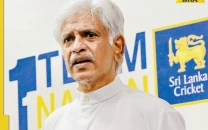Forced labour turns $150 billion in illegal profits each year: ILO
Nearly 21 million men, women and children are locked in forced labour.

Many are coerced into working as prostitutes, trafficked, or held in debt bondage and working in slave-like conditions. PHOTO: AFP
Nearly 21 million men, women and children are locked in forced labour, many coerced into working as prostitutes, trafficked, or held in debt bondage and working in slave-like conditions, according to the International Labour Organisation (ILO).
"Forced labour is bad for business and development and especially for its victims," ILO chief Guy Ryder said, stressing the need to "eradicate this fundamentally evil, but hugely profitable practice as soon as possible".
Some 18.7 million people forced to toil in the private sector rake in $150.2 billion each year for the people exploiting them, the ILO said in a report.
Two thirds of that amount, or $99 billion, is made from sexual exploitation and the rest from forced economic exploitation, such as domestic work and agriculture, according to the report, based on data from 2012.
Nearly 21 million men, women and children are locked in forced labour, with many working in slave-like conditions, the UN's labour agency says
"Unscrupulous employers and criminals reap huge profits from the illegal exaction of forced labour," the UN agency said, warning that the problem risked "growing in extent and profitability".
A further 2.2 million people are thought to be forced to work for the state, including some in prisons and by the military.
Among the victims, 5.5 million of them children, "many don't earn anything," Beate Andrees, head of the ILO's programme for combatting forced labour, told reporters in Geneva.
Asia-Pacific is home to more than half of forced workers worldwide, around 11.7 million people, who generate $51.8 billion each year for their exploitative employers.
Africa is next in line with 3.7 million forced labourers, followed by Latin America and the Caribbean, with 1.8 million.
Developed economies, where an estimated 1.5 million people are forced to work but their services are more valuable, make the second-highest profit, with ruthless bosses there jointly making $46.9 billion from illegal workers.
An estimated 600,000 are also forced to work in the Middle East, the report showed.
Andrees pointed out that progress had been made in reining in state-imposed forced labour, but stressed that "we must now focus on the socioeconomic factors that make people vulnerable to forced labour in the private sector."
ILO expert Corinne Vargha said the group's Forced Labour Convention from 1930, which mainly addresses the issue of state-coerced labour, may not be completely up to the task.
A protocol widening the convention to target forced labour in the private sector, with a range of prevention, protection and compensation measures, is set to be discussed during the ILO's next general assembly in Geneva from May 28 to June 12.



















COMMENTS
Comments are moderated and generally will be posted if they are on-topic and not abusive.
For more information, please see our Comments FAQ